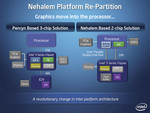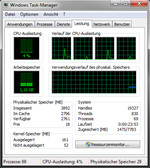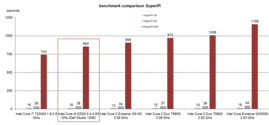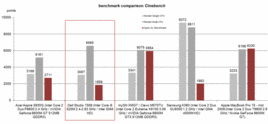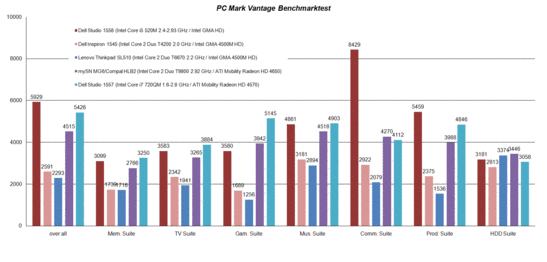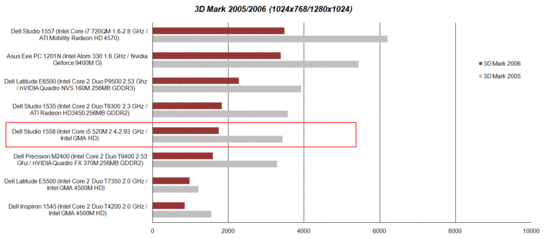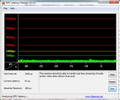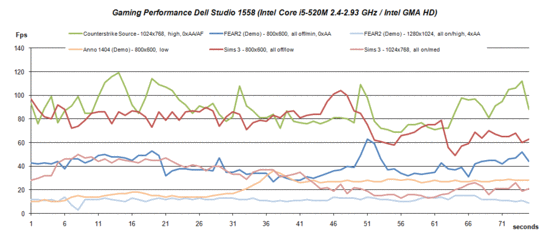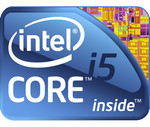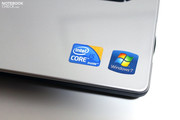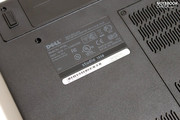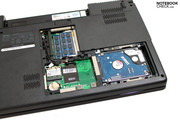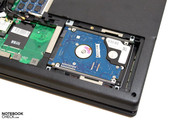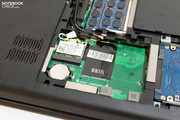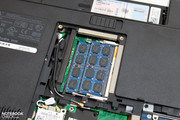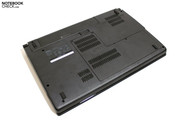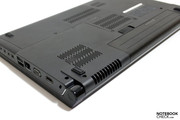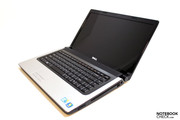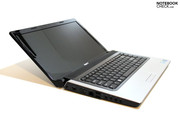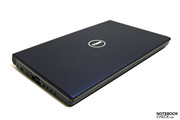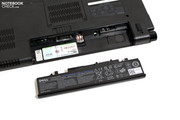Review Dell Studio 1558 Notebook
I just love reunions.
Already in its nth edition, Dell releases the Dell Studio 15, and promptly equips it with the most current hardware in light of the Intel Core i5 launch. In plain text this means a Core i5 520M at 2.4 Ghz and the Graphics Media Accelerator (GMA) HD graphics chip integrated onto the processor. Find out in this review whether this new combination confirms the suspicion of a price/performance champion.
Dell Studio 1557 is the specific appellation of the, until now, current version of the fancy multimedia specialist from Dell. On offer is/was a notebook with a Pentium Dual-Core, Core 2 Duo or respectively the high-performance Core i7 chips from Intel. A certain systematic application of performance was chosen to your whim or respectively as far as your pennies went. The entry-level configuration was around 479 Euro (plus delivery), equipped with an Intel T4300 CPU (2.1 GHz) and integrated Intel GMA 4500M HD graphics chip.
A pre-sample of the new Studio 1558 underlies the following review, equipped with a combination of the brand-new Intel Core i5 520M CPU and the just-as-new CPU-integrated Intel GMA HD graphics solution. Therefore the laptop appears in the entry-level range of the series and shouldn't cost much more than its predecessor of a comparable configuration. As seen in the Core i7 architecture, you can count on an enormous performance leap in the Core i5 dual-core CPUs, and a whole range of new features are carried over, which only recently catapulted the i7 chips onto the tops of the CPU charts.
Case
A quick peek at the case confirms our first observation: nothing much has changed on the case of the Studio 1558. Apart from a blue display lid ("Midnight Blue micro-satin surface) the laptop at hand can't be told apart from the already reviewed Dell Studio 1557. Oh well, the Intel Core i5 sticker is new, but on first glance it's a spitting image of the i7 sticker.
Regarding the case there's nothing more to say, apart from pointing to the relevant passage of the Studio 1557, to which the current device corresponds. The key points to mention here are consequently the customisable case (display lid), but also weaknesses concerning the stability of the display lid.
Connectivity
Along with the case, the notebook's ports on offer are the same. The connections are limited to the sides of the case like before; the front and rear of the notebook remain free from interfaces. As for the number of offered interfaces, no hairs will be on end; the Studio 1558 sports 3 USB ports, HDMI, eSATA and Firewire ports. However, the positioning of these ports needs some getting used to. The location of the Expresscard Slot is just over the card reader, which isn't optimal by any means, and left-handed users have to make do with a wide phalanx of connections when using an external mouse.
Input Devices
Once again it suffices to refer to the existing review of the predecessor, Dell Studio 1557. When it comes to the keyboard unit basically nothing has changed, with the exception that in the sample at hand a keyboard with English layout was used. The single-row enter key is nevertheless omitted in the German layout, as usual, and you can delight in the double-height enter key.
The touchpad is embedded in the wrist rest area making it almost flush and it offers pleasant gliding qualities with good reaction behaviour. A soft gap towards the outer edges characterises the input device and facilitates navigation.
Display
The last time that we refer to the existing review of the Studio 1557 regards the display. In the pre-sample of the Studio 1558 we also found a LED display with a 15.6-inch TrueLife panel, that is, a reflective glare surface. The maximum resolution adds up to 1366x768 pixels in the 16:9 format and thus supports the playback of HD media.
The measured results we obtained regarding display brightness correspond to those of the Studio 1557 with a possible deviance of up to around 15%. Reasons for the difference could be manufacturing margins, haziness with the measurements, or different panel types could be used. In the notebook at hand there was an InnoLux 156GW01 panel. In the already reviewed Studio 1557 the specific panel type could not be read.
| |||||||||||||||||||||||||
Brightness Distribution: 87 %
Center on Battery: 136.1 cd/m²
Contrast: 160:1 (Black: 1.46 cd/m²)
You'll have to come to terms with reflective display surfaces, because the alternative Full HD display with WLED illumination also has the same finish. Outdoor use thus becomes rather problematic, as you have to deal with strong reflections in unfavourably bright surrounding light, which can even appear in average, bright indoor rooms.
Performance
For those who have angrily scrolled past the first passages and are just in search of more detailed information about the brand-new Intel CPU and graphics combination, it's now that it gets exciting. For now a short foray into the key data of the i5 chips; details can be found in our special article on the global Intel CPU launch. Shortly you can also find an extensive comparison of current Core i3/i5/i7 chips here on notebookcheck.net.
Intel Core i5 CPU
The deployed i5-520M CPU is manufactured in the 32 nanometer process and offers two physical computing cores and can respectively simulate a total of four threads via Hyper-Threading. The chip has 3MB cache and supports 1066MHz DDR3 RAM. With a Thermal Design Power – TDP of 35W the CPU is on the level of the hitherto existing Core 2 Duo Txxx chips. Through a range of features the energy consumption should nevertheless turn out to be very low on the whole.
An important feature concerning this would be the possibility to completely deactivate a core, as long as the core isn't used. In a conventional dual-core, both cores idle along. An excellent solution is presented by Turbo-Boost technology in order to unite performance and energy efficiency. The CPU can be flexible in terms of clock speed according to the required performance. In the case of our test sample's i5-520M the basic clock speed varies from 2.4 Ghz up to 2.93 Ghz, always bearing in mind the cooling performance of the system that's available.
An important point is of course the price of the new chips. The i5 520M CPU is produced by Intel with a market price (1000k units) of 225 US Dollars. For this reason the chip ranges between the hitherto existing P8400/P8600 and P8800 processors ($209) and the T9400/T9550 ($316) in terms of price.
In terms of performance, Intel speaks of an increase of up to 34% in multi-tasking (PCMark Vantage) and a productivity increase of 20% (Sysmark 2007) when comparing a P7550 Core 2 Duo CPU at 2.26 Ghz with the Core i5 430M at 2.26-2.53 GHz. As both cores deal with dual-core architectures with the same basic clock speed, this is a thoroughly respectable increase.
Intel GMA HD graphics chip
Apart from the improvements mentioned above, the new Nehalem architecture has another fundamental difference to the existing Penryn chips. Intel now integrates the graphics chip directly onto the CPU unit, which is also visually similar to the first multi-core CPUs.
The integrated graphics chip is now called Graphic Media Accelerator (GMA) HD and is manufactured in the 45 nanometer process. It's also here that Intel makes an enormous leap in the downsizing of the assembly, which is only allowed by the integration onto the CPU unit. As communication with the graphics chip (and the memory controller) via Frontsidebus no longer takes place, together with the new architecture of the GPU, a clear performance leap is seen.
Intel names several new features, like "switchable graphics"; the possibility to change between a more powerful dedicated graphics card and the energy-saving GMA HD, which is already existent on each i5 chip.
As a highlight the possibility of Dolby True HD and DTS-HD Audio is also cited.
Generic benchmarks
We begin with the CPU benchmarks for rating the processor performance of the Intel Core i5 chip. In the well known SuperPi Benchmark for the computation of the number Pi to a preset precision (millions of decimal places) the Core i5-520M reached an excellent 854 seconds in the 32M test. Therefore the chip is on the same level as the Core i7-720QM CPU that reaches a value of 857-839 seconds (fewer=faster=better). For this reason the middle-class CPU can even outperform former dual-core heavyweights like the Intel Core 2 Extreme X9100 CPU (906 seconds).
The Cinebench Rendering Test is also exciting. It simulates rendering an image with support of not only a single core but also with the help of all cores available. In the Single Core Rendering Test the Dell Studio 1558 with Intel Core i5-520M reaches a respectable 3067 points (32bit). Thus the chip is in the ranks of high-performance Dual-Core chips (X9000, P8700, T9600).
This level also remains in the Multi-Core Rendering Test. At 6585 points, the processor is to be found in the region of the aforementioned processors or respectively above these. Also strong T9900 chips are to be found just above the i5-520M CPU. The quad-core Core i7-720QM is actually ranked considerably higher (performing up to +50% better).
Thanks to the 64-bit operating system the Studio 1558 is also open to the 64-bit variant of the benchmark test. At 3724 and 8116 points respectively in the Single/Multi CPU Rendering Test a clear improvement of the results can be found.
The PC Mark Vantage benchmark test offers the possibility to classify the overall performance of the system, and also evaluates the respective test system in terms of the whole spectrum of individual tests.
To get straight to the point: the result of the Dell Studio 1558 with Intel Core i5-520M is impressive. We chose to compare the system with the Inspiron 1545 and the Thinkpad SL510 which are above all two office entry-level machines. We did this in particular to judge the performance of the GMA HD in comparison with the hitherto existing 4500M HD. The "gaming suite", of the GMA HD, onto which of course quite a lot of weight on graphics performance is put, exhibits more than double the performance compared to the 4500M HD.
Our test configuration was no less imposing in the other subdomains. Even strong multimedia notebooks like the mySN MG6 with a T9800 CPU and HD 4650 graphics cannot keep up, apart from in the gaming test and the HDD test, which is limited by the hard disk. Only the Dell Studio 1557, that is the predecessor of our test sample, equipped with a Core i7-CPU and potent ATI HD4570 graphics, can top the results of the i5 GMA HD combination in many places. The unusually good result in the communications suite was on the whole striking, where the system performed almost twice as well compared to miscellaneous comparable devices.
Here the new Crypto-unit of the i5 CPU could get its chance, as AES Encryption is a basic component of the communication test of PC Mark Vantage. This feature is new and even hasn't been used on the i7 processors. The Studio 1558 outperforms its more high-performance predecessor, the 1557 in the overall rating, and a good part of this can be accounted for by the unusually high communications rating.
| PCMark Vantage Result | 5929 points | |
Help | ||
The good result for the new Intel Graphics Media Accelerator HD in the PC Mark Vantage of course inspired our interest in graphics performance. For a comparison we turned to the still widespread 3D Mark 2006 benchmark test, also in order to be able to put the results of somewhat weaker, older systems in perspective.
Not only the older and more CPU-independent 3D Mark 2005 but also the 3D Mark 2006 benchmark test confirm a good performance for the Intel GMA HD graphics chip. At 1743 points (3DM 06, 1280x1024) the Intel GMA HD chip is positioned on the level of a Nvidia Quadro FX 370M graphic solution or respectively just behind the ATI Mobility Radeon HD3450 entry-level graphic solution. Systems with the hitherto existing Intel GMA 4500M HD graphic solution remained just under the 1000 points range and thus were around 40% under the GMA HD solution.
| 3DMark 2001SE Standard | 9513 points | |
| 3DMark 03 Standard | 4926 points | |
| 3DMark 05 Standard | 3429 points | |
| 3DMark 06 Standard Score | 1743 points | |
| 3DMark Vantage P Result | 339 points | |
Help | ||
Even just a minor point in this review, the deployed hard disk shouldn't be ignored, as it indirectly contributes to the individual results with its performance. The deployed hard disk, with a net capacity of 320GB, works at a speed of 7200 rpm, and is manufactured by Seagate. With average transfer rates of 73.5 MB/sec and an access time of 16.6 milliseconds, the unit has good results, which corresponds to the results of already-tested similar models. For this reason the storage medium is among the most high-performance conventional hard disks (see our benchmark list of mobile hard disks).
DPC latencies
Of course, you should be careful rating driver-related benchmarks with a pre-sample, as changes can still be made on the software side before the system is released to consumers. Our test sample nevertheless figured well in the test with DPC Latency Checker with consistently low latencies.
Yes, the Dell Studio 1558 is, in the configuration at hand, anything but a notebook designed for gaming, yet the good performance of the new Intel GMA HD graphics solution makes us all the while curious about how it gets on with individual games. We paid particular attention to somewhat older but nevertheless persistently popular games as well as several new games, from which somewhat lower GPU performance can be expected.
Couterstrike Source
If a game earns the title "classic", Counterstrike is one of the first nominees for the title. CSS is a re-worked version (2004) of the ego-shooter released in 1999, refreshed with the Source graphics engine (Half-Life 2). With it also came a clear graphical overhaul.
We tested at a resolution of 1024x768 pixels, high details, 0x Anisotropic filtering and anti-aliasing. In the practical gaming test the Dell 1558 had a good performance at an average of 79 Fps. Therefore the game was playable problem-free; the frame rate constantly remained over the 60 Fps mark.
The GMA 4500M HD in this set-up comparatively reaches around 40 Fps, an ATI Radeon 3200 around 65 Fps. As a result the GMA HD graphics should also position itself here according to its performance in the 3D Mark Test.
HalfLife 2 – Lost Coast
The "Lost-Coast-Benchmark" also shows good playability in a somewhat younger game. At a resolution of 1024x768 pixels and high presets, the benchmark reaches 47.44 Fps. This is again the level between a Nvidia Quadro FX 360M and an ATI Mobility Radeon 4350 graphics card.
Sims 3
Our practical test shows that the "virtual puppet house" poses no problems with the prospective weakest GPU solution. With low graphic demands, (800x600, low, all off) Fraps measured an average of 82.1 Fps. The frame rates remained constantly over the 50 Fps mark.
Increasing the details to medium (1024x768, medium, everything on) meant that the result fell to an average of 29.72 Fps whereby drops under the 20 fps mark are to be seen.
If you compare this result with our game database, the GMA HD graphic solution positions itself above the results of the Ion solution from Nvidia, whose results are obtained from the combination with the weak Atom CPU. The performance level of a Geforce G 102/105 M indeed seems realistic.
Anno 1404
Finally we tried the strategy hit, Anno 1404. We tested the game at the lowest possible settings (800x600, low). When playing the demo Fraps measured an average of 21.6 fps. The fps run-through showed results that were from time to time below 20 fps and respectively around 30 fps. Subjectively the game was still only just playable at these settings.
In terms of performance the Intel GMA HD ranks somewhat behind the Nvidia Ion solution (Geforce 9400M G).
Verdict: the until now integrated graphics solution, the GMA 4500M HD, has no chance against its successor. The individual benchmark results are in places almost doubled and also in many practical gaming tests results can be reached that were until now reserved to (older) dedicated graphics cards. The performance should suffice for many current games at the lowest details, and older games at medium-high details. The modest casual gamer can be thoroughly happy with the "Intel GMA HD Graphics" graphics card.
Emissions
System Noise
After turning on the notebook you can notice a periodic running of the fan that after a few minutes develops into constant running. The noise level of 35.7 dB(A) is maintained at average office load. Subjectively the fan can be described as present but not truly disturbing.
If you load the core components, that is the CPU and GPU, the Dell Studio 1558 reaches a maximum of 46.1 dB(A). The laptop can thus be described as becoming almost unpleasantly loud. Presumably it's the high TDP of the CPU, at 35W, that plays an important role. As the fan remains on the maximum level under gaming load also it could mean that our pre-sample didn't have optimal fan regulation.
Noise level
| Idle |
| 35.7 / 35.7 / 35.7 dB(A) |
| HDD |
| 35.9 dB(A) |
| DVD |
| 37.7 / dB(A) |
| Load |
| 46.1 / 46.1 dB(A) |
 | ||
30 dB silent 40 dB(A) audible 50 dB(A) loud |
||
min: | ||
Temperature
Without load the case of the Dell 1558 remains particularly cool. On the upper side of the base unit the measured temperatures didn't even reach the 30°C mark. On the underside the result really doesn't turn out much higher. The maximum temperature recorded here was only 30.6°C.
After loading the system for at least an hour (Furmark, Prime95) the laptop correspondingly warmed up and afterwards the upper side of the base unit reached a maximum of 39.4°C. The wrist-rests, however, still remained under the 30°C mark and the laptop thus remains pleasant to use.
On the underside of the base unit peak values of just short of 50°C can be recorded. The particularly thin and light power adapter from Dell (380g) provided authentic record values. In the case of the Studio 1558 this warmed up to a maximum of 62.8°C.
(+) The maximum temperature on the upper side is 39.9 °C / 104 F, compared to the average of 36.9 °C / 98 F, ranging from 21.1 to 71 °C for the class Multimedia.
(-) The bottom heats up to a maximum of 49.5 °C / 121 F, compared to the average of 39.2 °C / 103 F
(+) In idle usage, the average temperature for the upper side is 28 °C / 82 F, compared to the device average of 31.3 °C / 88 F.
(+) The palmrests and touchpad are cooler than skin temperature with a maximum of 29.9 °C / 85.8 F and are therefore cool to the touch.
(±) The average temperature of the palmrest area of similar devices was 28.7 °C / 83.7 F (-1.2 °C / -2.1 F).
Loudspeakers
Subjectively the offered sound showed no differences to the already reviewed Studio 1557. More detailed information concerning this can also be found in this review.
Battery Life
If you compare the achieved battery life with that of the already reviewed Studio 1557 with a more high-performance configuration (Core i7 720QM, ATI 4570), the 1558 records slightly gains in all domains, which are primarily down to the energy-saving Intel GMA HD graphic solution.
As a maximum the Studio 1558 reaches a battery life of 290 minutes in the BatterEater Readers Test. Under load in the worst-case scenario, the laptop holds on for 70 minutes with the deployed 62Wh battery.
The practical battery life, like WLAN surfing with maximum display brightness, was 170 minutes on the Dell Studio 1558. Playback of a DVD was a still practical result of 160 minutes, which should suffice for an extended Hollywood title.
Regarding energy consumption the laptop also scores points. A minimum energy consumption of 12.3 Watt was recorded (minimum display brightness, communication modules off, energy-saving mode). The Eee 1201N netbook from Asus is somewhat on the same level. Under gaming load the device requires an average of 43.7W. If you purposefully load the core components an absolute maximum of 59.3 Watt was recorded.
Compared to the Pxxx Core 2 Duo models from Intel (25W TDP) and chipset graphics, the TDP of 35W (CPU+GPU) in the new i5 processors under load seems rather played out, as the CPU constantly changes its TDP and seeks to provide the maximum possible performance available.
| Off / Standby | |
| Idle | |
| Load |
|
Key:
min: | |
Verdict
The foundations even stay the same and hence offer the same pros and cons of the current Studio 1558 chassis. The pleasant input devices, which are pleasing even for extensive typing work, the good workmanship, and the excellent connectivity, all add up.
Indeed, you should take into consideration the potentially unfavourable positioning of the interfaces depending on how you plan to use the device. Also, you should consider the particularly hot power adapter under load and, as long as this doesn't get corrected, the potentially high system noise under load.
The new i5 CPU generation from Intel has convinced us without reservations, or rather the Core i5-520M chip used in our test configuration, whose performance data is geared towards the most high-performance Core 2 Duo CPUs, and which is to be found on the level of the Core i7-720QM in applications without quad-core optimisation.
Also there's the newly integrated graphics solution, the Intel GMA HD, that now sits directly on the CPU unit, which in places provided astonishing performance. The true potential will indeed be seen in hybrid solutions, that is to say the combination of integrated GPU with an independent graphics card, whereby the switch, depending on performance needs, can quickly and easily take place. In this way, multimedia notebooks can combine high performance with high battery performance and so their reputation as all-rounders can finally be without limits.















